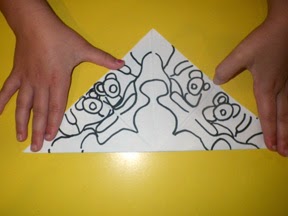Wednesday, July 30, 2014
Symmetry - Reflective
Reflective symmetry is when one half of an object is a mirror image of the opposite half. The line of symmetry can be vertical, horizontal or at any angle in between!
For this project we used white watercolor paper, water based markers, water and a paint brush.
We folded the paper in half, open the fold and refold in the opposite direction (this makes the ending step a little easier). Place the paper fold side toward the children. Using the watercolor markers have the children draw a picture or design.
Then unfold the paper with the drawing facing up and using the paint brush, paint the water on the blank bottom half of the paper.
Then fold the top half of the paper with the drawing down over the wet half and press/rub together. Carefully open the paper to reveal the reflective pattern!
Symmetry - Rotational
Rotational symmetry is when an object can be rotation on a central point and look the same. For this project we cut a sheet of white paper into a square and folded it corner to corner 3 times (like you would fold to cut out a paper snow flake). On the top triangle the children can draw their starting pattern. We drew our names or simple designs.
Then, unfold one fold and use a window or light board (we used our glass front refrigerator!) and trace your design on the blank triangle. Repeat this - unfold and flip/turn the paper as needed - to trace the design on all 8 creased triangle areas.
Then open all the folds to reveal the rotational symmetrical design!
For some added fun, we decided to add color to our designs. Remember it has to be symmetrical so the colors should match in each triangle section too!
Wednesday, July 23, 2014
Symmetry with Random Objects
 |
| These are the supplies we used, but any variety of items will work for this project. Try to include a variety of texture and color to encourage creativity. |
We began our study by making a center line - a line of symmetry. Then with our partners we worked in pairs; one partner made a pattern on one side of the stick and the other partner mimicked the pattern on the other side of the stick to create the symmetrical design.

Wednesday, July 16, 2014
Free Lesson plan
Smart Squirrel will be selling lesson plans for children 3-6 years of age. Lesson plans include, songs, pictures, book list, games, and activities.
Get a free lesson plan for winter animals here:
Smart Squirrel Winter Animals Lesson Plan
Be sure to check back for future lesson plans.
Get a free lesson plan for winter animals here:
Smart Squirrel Winter Animals Lesson Plan
Be sure to check back for future lesson plans.
Sun catchers
 A little stinky but fun to make. We used plastic pony beads and glass bobbles. Children arranged them in a foil pie dish and metal cookie cutters and cupcake tins. Then we baked it 400 degrees for 15-20 min. placed them in the refrigerator for 5 minutes to cool, they pop right out. We used fishing line to sew them together.
A little stinky but fun to make. We used plastic pony beads and glass bobbles. Children arranged them in a foil pie dish and metal cookie cutters and cupcake tins. Then we baked it 400 degrees for 15-20 min. placed them in the refrigerator for 5 minutes to cool, they pop right out. We used fishing line to sew them together.Batik Art
 We drew a picture on a cloth lightly with a pencil. Then we applied water based glue on the lines. Let it dry for 24 hrs. Then we painted on the material using watered down acrylic paint almost like water colors. Let that dry 24 hrs. Then put the entire cloth into warm water to remove the glue. An interesting picture is left.
We drew a picture on a cloth lightly with a pencil. Then we applied water based glue on the lines. Let it dry for 24 hrs. Then we painted on the material using watered down acrylic paint almost like water colors. Let that dry 24 hrs. Then put the entire cloth into warm water to remove the glue. An interesting picture is left. Painting a stain glass picture
Tie-Dyeing
A day of tie-dyeing & exploring colors!
The children first played with different types of materials and tested each for how the dyes covered and reacted with each other. We tested silk, cotton and flannel.
We decided that cotton works the best!
Nature Collage
The
children gathered items from the yard. We sorted the different items
collected by colors. The children then selected items from the different
color groups to create their collage.
Subscribe to:
Comments (Atom)






































